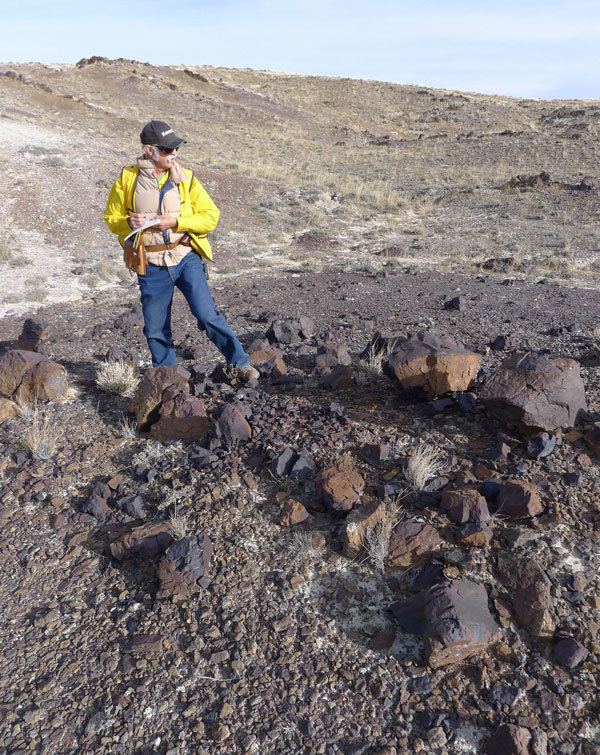NEWS RELEASE: WSGS Publishes Report on Wyoming’s Potential Iron Deposits
Wyoming State Geological Survey sent this bulletin at 08/27/2015 08:34 AM MDT |
|
Having trouble viewing this email? View it as a Web page. |
Aug. 27, 2015
******FOR IMMEDIATE RELEASE******
Media Contact:
Chamois Andersen
(307) 766-2286 x231
chamois.andersen@wyo.gov

WSGS Publishes Report on Wyoming’s Potential Iron Deposits
The Wyoming State Geological Survey (WSGS) recently published a report on Wyoming’s iron (Fe) resources, an important mineral used in the production of steel. Previous iron mining efforts have contributed to Wyoming’s economy, with the potential for the state to once again become an iron-producing state, given the right conditions (iron prices, global demand, etc.).
“The results of this study show iron-rich rocks occur across Wyoming and recent exploration indicates at least one potentially large and previously unknown deposit in the Rattlesnake Hills-Granite Mountain area,” says Wayne Sutherland, WSGS gems and minerals geologist. “Iron ore also remains in the Sunrise and South Pass areas, where historic mining occurred,” he says.
This WSGS mineral investigation was requested and funded by the Wyoming State Legislature. The WSGS is scheduled to present the results of the study to the Minerals Committee of the Legislature at its meeting today in Riverton, Wyoming.
Geologists sampled sites across the state based on previous state and federal iron investigations, known iron sources and historic iron mining locations. The 91-page report “Iron Resources in Wyoming, Report of Investigations No. 67” is available for $18 via the WSGS website or as a free download. The authors of the study are Wayne M. Sutherland and Elizabeth C. Cola. The report includes color photos and geologic maps of iron locations throughout the state as well as an appendix of all field samples, including analyses, locations and geologic settings.
Ore-grade iron deposits are what industry considers “economically mineable,” but often the major constraint for mining is how close the iron is relative to market. This includes the costs associated with transporting it by railroad. “The location of the ore and the market price of iron can make actual mining cost prohibitive,” says Sutherland.
Iron is usually found in the form of iron oxide minerals. In Wyoming this includes magnetite, Fe3O4 (72% Fe), and hematite, Fe2O3 (70% Fe). “Sites with iron occur in a variety of geologic environments in Wyoming,” says Sutherland. These include iron-rich sedimentary rocks known as banded iron formations (BIFs), which are primarily of Precambrian age (more than 600 million years old). “BIFs are the source rocks for most of the large high-grade concentrations of iron ore currently mined throughout the world,” says Sutherland.
Iron in Wyoming also occurs in placer-type magnetite-ilmenite sandstones, concretions and other rocks. Field work for this study involved collecting what geologists call “grab bag” samples. The samples were then sent to a laboratory where they were analyzed for major and trace elements.
Historically, iron has been a valuable resource for the state, providing raw material, jobs and economic development. In Wyoming, this resource dates back 13,000 years when Paleo-Indians mined hematite for red ochre in the area of the historic Sunrise Iron Mine (Platte County). In the late 1800s, the state produced concretionary hematite from the Rawlins area for use as paint pigment and as a smelting flux. Titaniferous magnetite, identified prior to 1850, has been mined sporadically from magmatic segregation deposits in the Iron Mountain area for use as a weight additive in cement. Between 1899 and 1980, BIFs of Archean age were mined in the Hartville Uplift (Sunrise area) and near South Pass (Fremont County), from 1962 to 1983. Iron from these locations accounted for more than 132 million tons of iron ore shipped out of state for iron and steel manufacturing. Over time, numerous smaller deposits in Wyoming have been investigated as potential sources of iron.
“This WSGS report is the first comprehensive statewide study that includes historical research coupled with current field investigations,” Sutherland says.
Iron (Fe) is the fourth most abundant elements on Earth, constituting about 5 percent of the its crust and accounting for a large portion of its core. Iron is the world's most commonly used metal – steel, of which iron ore is the key ingredient, representing almost 95 percent of all metal used per year. It is used primarily in structural engineering applications and in maritime purposes, automobiles, and general industrial applications such as for machinery and even for the cosmetics industry.
Additional mineral investigations authorized by the state Legislature include WSGS field research on Wyoming’s rare earth elements (a continuation of a previous WSGS report), zeolites and lithium (with reports scheduled for publication summer 2016).
Information on Wyoming’s mineral resources and previous reports are available on the WSGS website.
Photo: WSGS Geologist Wayne Sutherland evaluating iron concretions for study (WSGS photo, 2015).
###
You are subscribed to All News Releases for Wyoming State Geological Survey. This information has recently been updated, and is now available.

